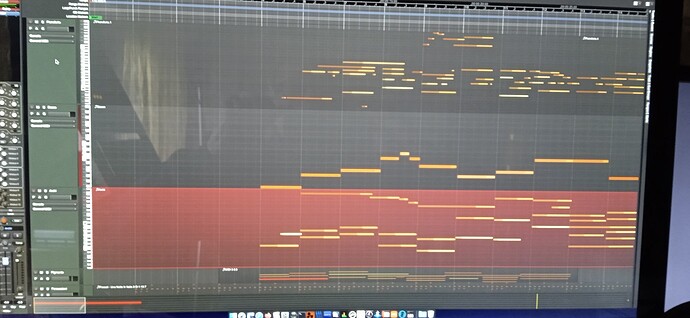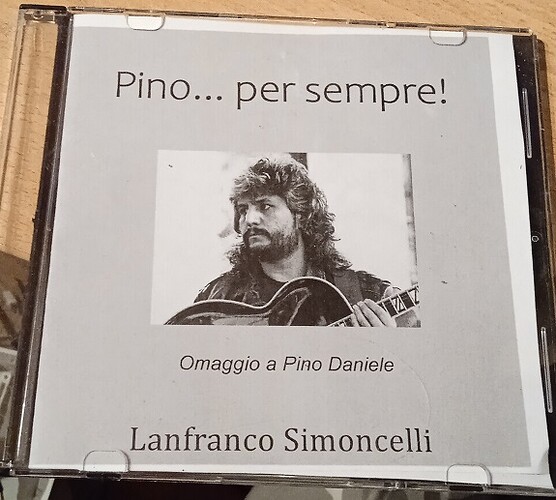From these notes of the intro of “Una notte in Italia” you can see that I start to spread the notes (the strings are those of the highlighted track) and avoid making chords.
The first track at the top is piano, the second is bass.
Hello @Lanfranco ![]()
Just a few notes of advice and comment, stemming from what I can gather of your screenshot:
-
I can see that you are experimenting with avoiding to arrange an orchestral section by static chords: that is the right direction.
-
I equally notice that you are trying to shape the lines of internal parts in a vocal fashion, proceeding by adjacent steps or small leaps, which is recommendable in order to achieve a true sense of combined separate melodies.
-
The onset of your orchestration seems to vary from two to six parts: this is not technically viable in an accomplished orchestration idiom, unless your full lineup is meant to be six stringed instruments. You should rather decide what your orchestral voicing is, and stick to it in a consistent way. Either you’re writing for acoustic sampled instruments or synthesizer/artificial parts, your ideal section’s arrangement should be:
Vl1, Vl2, Vla, Cello (4 voices),
or
Vl1, Vl2, Vla, Cello, Cbass (5 voices).
I advise you to try and write your arrangement within this standardized constraints, because respecting them would perceptibly afford greater solidity and plausibility to your musical flow.
- Use four or five separate tracks-parts for your orchestral section, instead of a compound Midi channel. This will prevent you from falling back to the chordal attitude, and give you a fuller and more coherent command of the different parts.
Cheers!
I will definitely try, thanks… but I have to tell you something in secret… Thousands of years ago I entered the Bologna Conservatory, but then I started to do badly at the Industrial Technical Institute (my father wanted me to be an engineer… …) and so they made me stop at the Conservatory where I only had time to have a smattering of solfeggio… not much… I played the sax in a band where I started reading music again… but all this to say that I don’t read very well and I don’t know how to write music… ![]()
I come from Classical Music, only in the 80s did I move on (not completely… Rachmaninov and Debussy remain my favourites…) to “modern” music (who is more modern than Debussy??). The boyfriend of one of my wife’s daughters graduated with top marks and since we call him “Sapientino” I wanted to record Mr. Bach’s Aria in Dmaj for him (Because it reminds you of Quark) … I did everything in a few hours so it’s not absolutely perfect but I want you to hear it…
Omnisphere: Soprano voice, Modern Choir
Kontakt: Strings
Never too late to start anew! ![]()
Hi ![]()
The Omnisphere soprano solo has a beautiful tone, although with too much operatic vibrato, for my taste and for the musical period of the composition.
Keep an eye on the solfege and the correct rhythmic meter of the über-famous piece (which is actually the second movement of the orchestral overture N.3 in D major).
As you can see from the score which I leave attached here (pages 54-55), what might be mistakenly perceived as a single flowing main line, sustained by a continuo moving by octaves, is actually the result of a closely knitted counterpoint between two violin parts, underpinned by viola and bass.
Have fun!
IMSLP01468-BWV1068.pdf (1.5 MB)
Thanks for the score… I used the simplified one… Then I have to say that at the time I recorded this piece, I didn’t give importance to the fact that a human being has to take a breath every now and then if he isn’t crossed with a sperm whale. … I’m putting the same thing into practice with virtual wind instruments… sometimes you hear sax solos that never stop and personally I’m very annoyed…
I attach the first measures of “Una notte in Italia”.
I used a track for violin 1 and one in which I overdubbed double bass, viola and cello… it’s an experiment but it changes everything… I study it…
Here with the other instruments:
I thank all the people who gave me advice and criticized me in a constructive way… I am VERY satisfied with the result… THANK YOU!!!
Today I recorded this other poem by Fossati as a test… Being in “free time” I recorded voice and Piano at the same time… I attach the text translated with Google translator because it deserves:
Love of the eyes
What eyes do you have
With your wounded breast
From your sense of crying
After running and searching a lot
Now what do you do
And I know you want me
And you’re afraid of me
And you would like another man for me
And I know you want me
And you’re afraid of me
And the right word is not forgiveness
Because there is never forgiveness
Because resentment is stronger than forgiveness
Because resentment is stronger than a man
The stronger the melancholy
The winter is longer
And the night
Moreover
Love of the eyes
What eyes you will have
When of anxiety and enchantment
Made the rounds of time
After running and searching a lot
You will wake up
New things and people
They will dance with you
The new rhythms of life
You already know well as of now
But you’ll know better then
Which is never over
Because it’s never over
Because if resentment was another life
If it was another man
Melancholy is sweeter
The winter is shorter
And the night
Moreover
Love of the eyes
What eyes do you have
Because it’s never over
Because if resentment was another life
If it was another man
Melancholy is sweeter
The winter is shorter
And the night
Moreover
UPDATE!!
Amore degli occhi (I. Fossati)
Zynthian: Piano
SWAM: Cello, Double bass, Violino (Thanks @Aethermind )
Invisibile (Ivano Fossati)
PianoteQ: Rhodes, Piano ( I ![]() PianoteQ)
PianoteQ)
SWAM: Cello
Omnisphere: Bass, AC Guitar, Jazz guitar
Pigments: Pad
EZ Drummer: Drums
In the intro of this piece I harmonized Violin, Viola, Cello and Double Bass. Then I used Pads… but I think that with infinite patience, I will replace the Pads with harmonized strings (thanks @Aethermind)
Una notte in Italia (Ivano Fossati)
Zynthian: Piano, Rhodes
Omnisphere: Bass
Kontakt: Strings ensemble
SWAM: Violin, Viola, Cello, Doublebass
MiniMoog: Pad
Pigments: Pad
EZDrummer: Drums, Percussion
Well, @Lanfranco
Among my favourite songs ever, and that which made me approach Fossati’s music, a long time ago.
It is also occasionally part of my vocal training routine, at a lower pitch to accommodate my range.
I noticed that in your version you eschewed the passing minor superdominant, but this is completely legitimate in the context of a personal re-enactment.
As for the orchestral/pad section, I am sure that one day you will find the time and stamina to fully rearrange it in separate parts.
Well done Lanfranco! ![]()
Prego? What??? ![]()
![]()
![]()
![]()
![]()
I think I have to come to your lesson… This music thing has been a real explosion. I’ve been studying for almost a year and every day I discover new things… a kind of emotional storm… I’ve been playing for a long time but I’ve never studied… the only thing that helped was playing without studying , it’s the taste of sound… I am perfectly clear about the sound I want and how I want it to behave… but between saying and doing…
When I lived in Bologna I had the honor of playing with very good musicians even though I was certainly not up to par… This is because (they told me) I always had the good taste not to exaggerate beyond the limits and because I had beautiful sounds ( this in particular when I played the trumpet for 8 years… I had a wonderful Bach Stradivarius… I made very few notes but with the greatest possible taste).
![]() My friends use to say that sometimes I should make contact with earth, when I speak about certain dearly nurtured subjects!
My friends use to say that sometimes I should make contact with earth, when I speak about certain dearly nurtured subjects!
You surely did a great job with Una Notte in Italia, and it is obvious that you have a long and painstakingly acquired expertise in music-making, besides an enviable degree of very youthful enthusiasm.
Cheers ![]()
A lot of passion… but I studied very little… one of the biggest mistakes of my life… Also because my hearing is getting worse with age… that’s why I’m in a hurry… ![]()
I asked the A.I. to explain to me the “passing minor superdominant”… “his” explanation disoriented me even more:
The “passing minor superdominant” in a chord progression is a cadence that leads to the next chord in a minor dominant mode. In the chord sequence you provided, to identify the “passing minor superdominant”, we need to look at the chord that precedes the next chord in the minor dominant mode.
Hi @Lanfranco !
Quite simply, the minor chord built on the sixth degree of a natural major scale.
Nothing too complex ![]()
Ok, I had seen a video by Valerio Silvestro on this thing… Unfortunately the names seem designed to complicate things… Tomorrow I’ll do some tests… this thing on all chords? Valerio would say: "if they sound good… do it where the ignorance of your ears says it’s good…) ![]()
![]()
![]()
Many thanks
Latest musical effort… ![]()
I always await constructive criticism on the performance and arrangement. Thank you
Notturno delle tre (Ivano Fossati)
Zynthian: Piano, Rhodes
Omnisphere: Bass, AC Guitar
Kontakt: N.I. Section Brass, Sanfona Accordion
SWAM: Trumpet
EZDrummer: Drums, Percussion
Here the going gets tough… This is a man who expresses sensuality with the maturity of his age and without absolutely being vulgar… Very tiring voice and difficult lyrics to express… Few chords and as always Fossati is based about her beautiful voice and very poetic lyrics.
L’Amante (Ivano Fossati)
Zynthian : Piano, Rhodes
Omnisphere: Bass
Pigments : Pad1, Pad2
SWAM: Soprano sax
Arturia: DX7 Piano
EZDrummer: Drums, Percussion

